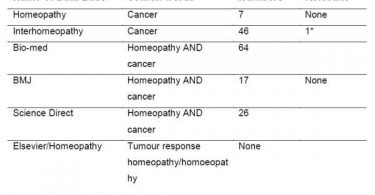Homeopathy has for a long time been a source of irritation to the orthodox medical industry. There are 3 major causes of this irritation:
- Homeopathy allows people to treat themselves independently of the medical establishment.
- Its use doesn’t require a medical diagnosis.
- Its medicines cannot be patented and therefore cannot be monopolised by any individual or organisation.
To rid itself of this irritation, orthodox medicine has established a well-planned propaganda strategy, one tactic of which has been to declare that there’s no evidence to support homeopathy. This is demonstrably untrue. Evidence for the benefits of homeopathy is plentiful and it’s easy to find. Following are some recent examples of human, in vitro, animal and plant research from peer-reviewed journals.
Human Research
- Raak C, et al. Effectiveness of a Homeopathic Complex Medicine in Infantile Colic: A Randomized Multicenter Study. Complement Ther Med, 2019, 45, 136-141. Data were drawn from a prospective, multicenter, randomised, open-label, controlled clinical trial that was conducted in 3 Russian outpatient clinics. 25 infants ≤ 6 months with colic received either Enterokind (Chamomilla D6, Cina D6, Colocynthis D6, Lac defloratum D6 and Magnesium chloratum D6) or Simethicone. The main outcomes assessments were the change of total complaints score (maximum 17 points) and total objective symptoms score (maximum 22 points) after 10 days of treatment. The differences in total complaints and objective symptoms scores between baseline and day 10, estimated from the ANCOVA model, were found to be highly significant (p < 0.0001; ITT) in favour of Enterokind, both for complaints (Δ=-2.38; 95% confidence interval (CI): [-2.87; -1.89]) and for objective symptoms (Δ=-2.07; 95% CI: [-2.65; -1.49]).
- Gaertner K, et al. Is homeopathy effective for attention deficit and hyperactivity disorder? A meta-analysis. Pediatr Res. 2022 Jun 14. In this study, 37 online sources were searched with a last update in March 2021. Studies investigating the effects of individualised homeopathy against any control in ADHD (ICD-10 category F90.0) were eligible. 6 studies were analysed. All but one were randomised and showed low-to-moderate risk of bias; 2 were controlled against standard treatment and 4 were placebo-controlled and double-blinded. The meta-analysis revealed a significant effect size across studies of Hedges’ g = 0.542 (95% CI 0.311-0.772; z = 4.61; p < 0.001) against any control and of g = 0.605 (95% CI 0.05-1.16; z = 2.16, p = 0.03) against placebo (n = 4). The effect estimations were based on studies with an average sample size of 52 participants. In conclusion, individualised homeopathy showed a clinically relevant and statistically robust effect in the treatment of ADHD.
- Frass M, et al. Homeopathic Treatment as an Add-On Therapy May Improve Quality of Life and Prolong Survival in Patients with Non-Small Cell Lung Cancer: A Prospective, Randomized, Placebo-Controlled, Double-Blind, Three-Arm, Multicenter Study. Oncologist. 2020;25(12):e1930-e55. Here, authors evaluated the possible effects of additive homeopathic treatment compared with placebo in 150 patients with stage IV non-small cell lung cancer (NSCLC), with respect to quality of life in the 2 randomised groups and survival time in all 3 groups. Patients received either individualised homeopathic remedies (n = 51) or placebo (n = 47) in a double-blinded fashion; and 52 control patients without any homeopathic treatment were observed for survival only. Quality of life as well as functional and symptom scales showed significant improvement in the homeopathy group when compared with placebo after 9 and 18 weeks of homeopathic treatment (p < .001). Median survival time was significantly longer in the homeopathy group (435 days) versus placebo (257 days; p = .010) as well as versus control (228 days; p < .001). Survival rate in the homeopathy group differed significantly from placebo (p = .020) and from control (p < .001).
- Talele G, et al. Randomized Double-Blind, Placebo-Controlled Feasibility Study, Evaluating the Efficacy of Homeopathic Medicines in the Prevention of COVID-19 in a Quarantined Population. Homeopathy. 2022;111(1):49-56. A 6 group, randomised, double-blind, placebo-controlled prophylaxis study was conducted in a COVID-19 exposed population in a quarantine facility in Mumbai, India. Each group received one of the following: Arsenicum album 30c, Bryonia alba 30c, a combination (Arsenicum album 30c, Bryonia alba 30c, Gelsemium sempervirens 30c, and Influenzinum 30c), coronavirus nosode CVN01 30c, Camphora 1M, or placebo. 6 pills twice a day were administered for 3 days. The primary outcome measure used was testing recruitment and retention in this quarantined setting. Secondary outcomes were numbers testing positive for COVID-19 after developing symptoms of illness, number of subjects hospitalised, and days to recovery. 2,233 subjects completed the trial. Subjects who were randomised to either Bryonia or to the CVN01 nosode showed (p <0.10) a lower incidence of laboratory-confirmed COVID-19 and a shorter period of illness, with evidence of fewer hospitalisations, than those taking placebo. The 3 other groups did not show signals of efficacy.
- Rai S, et al. Efficacy of Individualized Homeopathic Medicines in Treatment of Acne Vulgaris: A Double-Blind, Randomized, Placebo-Controlled Trial. Homeopathy. 2022;111(4):240-51. 126 patients suffering from acne vulgaris were randomised to receive either individualised homeopathic medicines (IHM) in centesimal potencies or identical-looking placebo (control). The primary outcome measure was the Global Acne Grading System score; secondary outcomes were the Cardiff Acne Disability Index and Dermatology Life Quality Index questionnaires – all measured at baseline and 3 months after the intervention. Group differences and effect sizes (Cohen’s d) were calculated on the intention-to-treat sample. Overall, improvements were greater in the IHM group than placebo, with small to medium effect sizes after 3 months of intervention; however, the inter-group differences were statistically non-significant. Sulphur (17.5%), Natrum muriaticum (15.1%), Calcarea phosphorica (14.3%), Pulsatilla nigricans (10.3%), and Antimonium crudum (7.1%) were the most frequently prescribed medicines; Pulsatilla nigricans, Tuberculinum bovinum and Natrum muriaticum were the most effective of those used.
- Karuppusamy A, et al. Individualized Homeopathic Medicines in Treatment of Vitiligo: Double-Blind, Randomized, Placebo-Controlled Pilot Trial. J Integr Complement Med. 2022;28(1):96-102. 60 people with vitiligo were randomised to receive individualised homeopathic medicines (IHMs) at 50-millesimal (LM) potencies or identical-looking placebos. Outcome measures were feasibility issues and scores from the Vitiligo Area Scoring Index, Vitiligo-specific Quality-of-life instrument, and Dermatology Life Quality Index, which were measured at baseline and after 3 and 6 months. On analysis of the results, mean reductions in the outcome measures were higher in the IHM group than placebo.
In Vitro Research
- Konar A, et al. High and ultra low concentrations of Mercuric chloride initiate their specific action on binding sites of invertase and modify its interaction with sucrose. Int J High Dilution Res. 2019;18(3-4):19-34. The aim here was to determine if homeopathically prepared Merc cor interacts with the enzyme invertase at its binding sites and influence enzyme’s action on its substrate, sucrose. Merc cor 200C and 1000C were prepared in 90% ethanol (EtOH). The two potencies and blank 90% EtOH were diluted with double distilled water (DDW) 1:1000 to reduce ethanol content to a negligible amount 0.09%. The control was DDW (0.99g/M). The drugs, EtOH and water control were mixed separately with 0.037 mM invertase in DDW. Using an isothermal calorimetry (ITC) instrument the substrate sucrose (65mM) was injected at 2 μl every 2 min into 300 μl invertase solution 20 times at 250C. A molecular modelling study was done to predict possible binding sites and nature of binding between the enzyme and HgCl2, and between the enzyme and water. Fluorescence spectra of invertase (4μM) mixed with drug/control solutions were also obtained to see the effect of drugs on protein folding. Thermodynamic parameters like binding constant, change in enthalpy, entropy and Gibbs free energy showed marked variation in treatment effects on the enzyme. Molecular modelling also showed variation in binding between invertase and Merc corr, and between invertase and water. Fluorescence spectra show variation in quenching related to different treatments. In conclusion, Merc cor potencies interact at different binding sites of invertase and modify the enzyme’s action on sucrose, they act as modulators of ligand, sucrose and induce conformational changes in the enzyme.
- Valle ACV, et al. Homoeopathic Viscum album(10-3) is more Cytotoxic to in vitro Culture of Human Breast Cancer Cell Line than to Human Mesenchymal Stem Cells. Int J High Dilution Res. 2020;19(4):25-34. MCF-7 is an adenocarcinoma of human breast cell line useful as pre-clinical model to screen therapeutic agents such as ultra-diluted Viscum album. AIMS MCF-7 and mesenchymal stem cells (MSC) were used to evaluate the in vitro cytotoxicity of homeopathic Viscum album 3X (VA3X). Cells were cultured for 24 hours in controlled environment in 96-well plates. After this time, VA3X was added to the culture medium in concentrations varying from 10 to 100 mL/mL. A control group was maintained with culture medium only. Cells were cultivated for 48 hours in these conditions for evaluation of cell viability by MTT assay. Higher cytotoxicity was observed in MCF-7 when compared to MSC, as the lower concentration of VA3X was capable of inducing tumour cell death and not healthy cell death. The MTT assay results were that 42 mL/mL of VA3X reduced MCF-7 cells viability to 50% and 62 mL/mL reduced MSC cells to the same percentage, indicating that the tumour cells were more sensitive to VA3X than healthy cells.
Animal Research
- Raj PAA, et al. Therapeutic Evaluation of Homoeopathic Treatment for Canine Oral Papillomatosis. Vet World. 2020;13(1):206-13. Authors evaluated the ameliorative potential of homeopathic drugs in combination (Sulphur 30C, Thuja 30C, Graphite 30C and Psorinum 30C) in 16 dogs affected with oral papillomatosis. Dogs were randomly divided into 2 groups- homeopathic treatment group and placebo control group, both administered orally twice daily for 15 days. Clinical evaluation in both groups of dogs was performed by the same investigator throughout the period of the study (12 months). Dogs were clinically scored for oral lesions on days at regular interval for 150 days after initiation of treatment. The homeopathic treatment group showed early recovery with a significant reduction in oral lesions reflected by clinical score (P < 0.001) in comparison to the placebo group. Oral papillomatous lesions regressed in the homeopathy group between 7 and 15 days and observed for 12-month post-treatment period; no recurrence of oral papilloma was observed. Oral papillomatous lesions regressed in the placebo group between 90 and 150 days and observed for 12-month post-treatment period; no recurrence of oral papilloma was observed.
Plant Research
- Banerjee S, et al. Effects of Ultra High Dilution of Paraquat 30 cH on Growth, Chlorophyll Content and Yield of Rice Crop. Int J High Dilution Res. 2021;20(2-3):16-23.The application of synthetic fertilisers reduces the natural fertility of the soil and contaminates groundwater. Some photosynthesis inhibitors at ultra-high dilution (UHD) increase photosynthesis, growth, and yield of crops. A weedicide Paraquat at UHD enhanced the growth and yield of potatoes in fields. The objective here was to see whether the UHD of Paraquat is also effective on rice. This weedicide was serially diluted with distilled water and manually succussed in 30 steps following the preparation of homeopathic dilutions. Paraquat 30C was diluted with water 1:1000 (v/v) and sprayed on rice plants in a field measuring 0.3125 acres. The control plot of the same area was situated 300 meters away from the test plot. 3 treatments were given at an interval of 7 days. The treated plot showed increased growth, chlorophyll content, and rice yield significantly compared to control. The UHD of the weedicide produced precisely the opposite effect of the crude material on plants. The increased growth and yield of rice by Paraquat 30C may be due to the enhancement of photosynthesis of treated plants. The UHD of Paraquat increased the yield of rice by 19.35% over the control.





